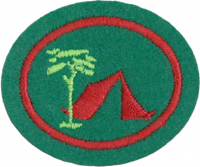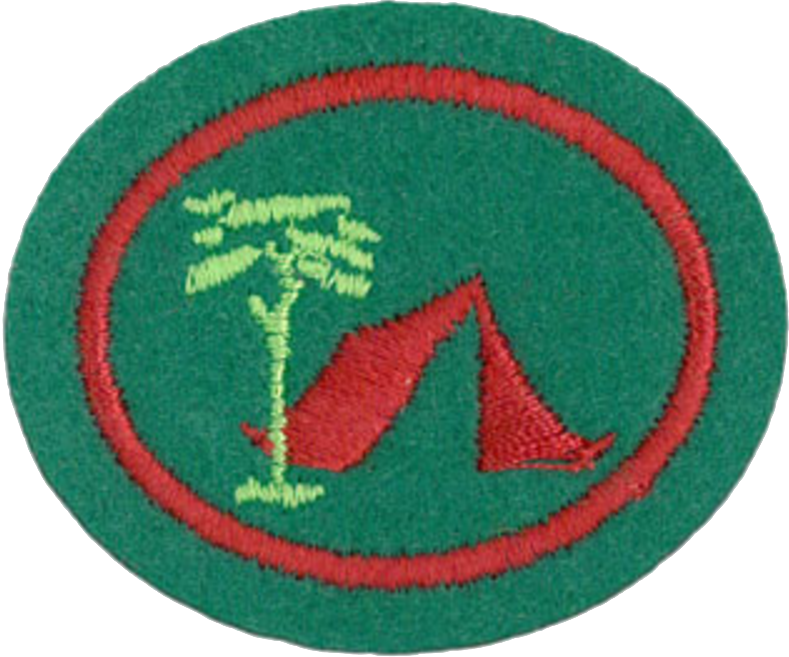Difference between revisions of "AY Honors/Camping Skills II/Answer Key"
Jomegat bot (talk | contribs) (Bot: Automated import of articles *** existing text overwritten ***) |
|||
| Line 1: | Line 1: | ||
{{HonorSubpage}} | {{HonorSubpage}} | ||
| + | {{ansreq|page={{#titleparts:{{PAGENAME}}|2|1}}|num=1}} | ||
{{ay camping grade level|II|6}} | {{ay camping grade level|II|6}} | ||
{{CloseReq}} <!-- 1 --> | {{CloseReq}} <!-- 1 --> | ||
Revision as of 21:52, 11 April 2021
1
Camping Skills II has been designed so that it is within the capabilities of Pathfinders who are in grade 6 or higher.
2
3
4
Going on a camping trip does not absolve you from the need for hygiene and sanitation – it merely makes it a little less convenient. If you are camping on an established campground, use the toilet facilities provided. Otherwise, you will have to provide your own facilities. If you are camping with a small group, this can be as simple as digging a cat hole (no more than 10 cm![]() deep, depositing your waste in the hole, and burying it again. A hole of this depth will be occupied by a myriad of bacterial life which will take care of the rest for you. If camping with a larger group, you will need to dig a latrine. Whether using cat holes or a latrine, make sure they are dug at least 60 meters
deep, depositing your waste in the hole, and burying it again. A hole of this depth will be occupied by a myriad of bacterial life which will take care of the rest for you. If camping with a larger group, you will need to dig a latrine. Whether using cat holes or a latrine, make sure they are dug at least 60 meters![]() from any water source.
When cooking, be sure to clean your dishes and kitchen area immediately after use. Again, how you do this depends on the size of your group. When camping with a small group, wipe all dishes, pots, pans, and utensils as clean as you can with paper towels. Burn the paper towels. Then you can scrub the dishes out with clean sand and rinse them off. When camping with a large group, you will need to establish a dish washing area. Fill two tubs with water – use hot water if possible (and it almost always is). You can boil a small quantity of water and add it to a larger volume of cold water, and this will do nicely. One of these tubs will be for washing, the other for rinsing. You can optionally use a third tub for pre-rinsing, which will eliminate the need to wipe the dishes with a paper towel before washing. Add 15 ml
from any water source.
When cooking, be sure to clean your dishes and kitchen area immediately after use. Again, how you do this depends on the size of your group. When camping with a small group, wipe all dishes, pots, pans, and utensils as clean as you can with paper towels. Burn the paper towels. Then you can scrub the dishes out with clean sand and rinse them off. When camping with a large group, you will need to establish a dish washing area. Fill two tubs with water – use hot water if possible (and it almost always is). You can boil a small quantity of water and add it to a larger volume of cold water, and this will do nicely. One of these tubs will be for washing, the other for rinsing. You can optionally use a third tub for pre-rinsing, which will eliminate the need to wipe the dishes with a paper towel before washing. Add 15 ml![]() of bleach to the rinse water. Wipe the dishes as clean as you can first (or pre-rinse them), then wash them in the first tub with dish soap. Then rinse. Wash the eating dishes first, followed by the cooking dishes. When finished, dispose of the "grey water" as directed by campground management (if on a campground). Otherwise, dispose of the grey water at least 60 meters
of bleach to the rinse water. Wipe the dishes as clean as you can first (or pre-rinse them), then wash them in the first tub with dish soap. Then rinse. Wash the eating dishes first, followed by the cooking dishes. When finished, dispose of the "grey water" as directed by campground management (if on a campground). Otherwise, dispose of the grey water at least 60 meters![]() from any water source.
from any water source.
5
6
6a
6b
6c
6d
7
8
Dead wood can also be broken instead of sawn. This is often easier and quicker than sawing it, but care must be taken to do this properly, and it can only be done on smaller logs - up to 7 cm![]() in diameter or so. To do this, again, the log is propped up on a support on one end, while the other end lies on the ground. Then the camper brings his foot down sharply about 12-18 inches (30-45 cm) from the support, between the support and the ground. Be careful to keep your footing while doing this, and watch that the ends of the log do not fly off.
in diameter or so. To do this, again, the log is propped up on a support on one end, while the other end lies on the ground. Then the camper brings his foot down sharply about 12-18 inches (30-45 cm) from the support, between the support and the ground. Be careful to keep your footing while doing this, and watch that the ends of the log do not fly off.
9
Adventist Youth Honors Answer Book/Camping/Fire/Fuzz sticks Adventist Youth Honors Answer Book/Camping/Fire/Council Adventist Youth Honors Answer Book/Camping/Fire/Hunters Adventist Youth Honors Answer Book/Camping/Fire/Fire safety
10
11
12
Adventist Youth Honors Answer Book/Camping/Boiling Adventist Youth Honors Answer Book/Camping/Frying Adventist Youth Honors Answer Book/Camping/Baking
13
14
14a
14b
14c
Note


